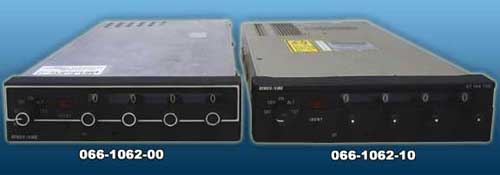| Part #: | |
|---|---|
| Model: | KT-76A |
| Desc: | Transponder |
| OEM: | BendixKing |
| NSN: | |
|---|---|
| Sched-B: | 8526100010 |
| ECCN: | |
| Cage Code: | 22373 |
 Select part number above to view pricing and availability.
Select part number above to view pricing and availability.
| Price | Condition | Availability | Stock Info | |
|---|---|---|---|---|
| Price | Cond. | Avail. | Stock Info | |
| $1,550.00 | SV OUTRIGHT | 2 IN STOCK |
Serial #: 123424 [Details]
Serial #: 82828 [Details]
|
| Price | Condition | Availability | Stock Info | |
|---|---|---|---|---|
| Price | Cond. | Avail. | Stock Info | |
| REQUEST | OH OUTRIGHT | REQUEST LEAD TIME |
|
| Price | Condition | Availability | Stock Info | |
|---|---|---|---|---|
| Price | Cond. | Avail. | Stock Info | |
| $1,550.00 | SV OUTRIGHT | 1 IN STOCK |
Serial #: 101432 [Details]
|

KT-76A
FEATURES
- 4096 code, Mode A/C, Class 1A, panel-mounted ATC transponder
- Altitude reporting capability
- System test feature
- All encoder and decoder functions built into single, plug-in Large Scale Integration chip
- IDENT button may be remotely mounted
- 200 watts peak minimum transmitter power
- 14 volt, but can be 28V with optional conversion kit
- Operates up to 35,000 feet
- Models available with either white or blue/white lighting (see table below)
- TSO'd
SPECIFICATIONS
| Size: | 6.25"W x 1.63"H x 10.0"L | Weight: | 3.1 lbs. |
| Applicable Documents: | TSO C74b, RTCA DO-138, DAPBBBXXXXXX Class I | Temperature Range: | -15 to +55C for continuous operation |
| Transmitter Frequency: | 1090 MHz +-3 MHz | Receiver Frequency: | 1030 MHz (crystal controlled local oscillator |
| Receiver Sensitivity: | -74dBm (nominal); -72dBm (min. for 90% reply) | Mode A Capability: | 4096 identity codes plus Special Identification Pulse |
| Mode C Capability: | Accepts standard ICAO Altitude Transmission Code digitizer output, reporting in 100 ft. increments from -1000 ft. up to 63,000 feet | Side Lobe Suppression: | 3 pulse |
| Part Number: | Description: |
|---|---|
| 066-1062-00 | Standard version with white lighting, Transponder |
| 066-1062-02 | Same as -00 unit but with blue/white lighting, Transponder |
| 066-1062-10 | Crown series version with solid black face and no silver lining trim |
NSN: 5895-01-269-4441
| Price | Condition | Status |
|---|---|---|
| $1,550.00 | SV OUTRIGHT | 2 IN STOCK |
| Price | Condition | Status |
|---|---|---|
| $1,550.00 | SV OUTRIGHT | 1 IN STOCK |
| Price | Condition | Status |
|---|---|---|
| REQUEST | OH OUTRIGHT | REQUEST LEAD TIME |
Click on a question below to see the answer. If you have a question about this model that is not answered below, please contact questions@seaerospace.com
Why do some parts indicate "REQUEST" or “RFQ” on the Southeast Aerospace website?
In relation to NE (New) parts, many OEMs change their prices and availability without any notice to dealers or the industry. Therefore, through the REQUEST or RFQ indication, we ask that customers contact us for the most accurate price and availability.
In relation to SV & OH parts, the used parts aftermarket in the aviation industry is not an infinite supply. It is a dynamic, constantly changing market that is significantly affected by and susceptible to highs and lows in supply and demand. Therefore, although we attempt to, at times, we are unable to predict the exact moment when an item may be available. Once again, through the REQUEST or RFQ indication on our website, we ask that customers contact us for the most current and accurate price and availability.
Is the KT-76C a direct replacement for the KT-76A?
For the most part, the KT-76C is a direct fit and form replacement for the KT-76A. However, there are considerations when replacing a KT-76A that was installed into a 28V aircraft installation. The original KT-76A utilized a voltage changeover (i.e. dropping resistor) kit for the KT-76A to be installed to a 28V installation. The KT-76C was designed to operate from any input voltage of 11-33 VDC. Therefore, the dropping resistor is not needed for the KT-76C in a 28V aircraft. The original droppiong resistor is removed from the original KT-76C wiring harness. In addition, the harness fuse needs to be changed from 3A to 5A. If an RFI suppression adapter was installed originally, then it must be removed as well.
Is the King KT-76A Transponder a direct replacement for the older KT-76 transponder?
Is the KT-73 Datalink Transponder a direct replacement for the KT-76A Transponder?
What type of faceplate / bezel assembly does the KT-76A have and what is this important?
What is the difference between Honeywell (Bendix/King) part numbers with 9 digits vs. 12 digits?
Why did Bendix/King change their part numbers from a 9 digit to a 12 digit format?
Different software versions imply different operational features and/or interface capabilities and software modifications imply software repairs (bug fixes) to insure proper operation of these features and interfaces. Software version upgrades frequently require hardware modifications to the unit. Such hardware modifications accompanying software version upgrades do not necessarily change the hardware version of the unit.
What is the difference between the Silver Crown and Crown Series version of the KT-76A?
Please see the example below of the different versions:

What Type of Transponder Do You Need?
Should a new transponder certification be performed if simply replacing an existing transponder?
For complete information, please refer to these FAA regulations or contact Southeast Aerospace Tech Support team at shop@seaerospace.com.
I cannot locate a KT-78A transponder, what can I replace it with?
The KT-78A is simply a low power version of the popular KT-76A transponder. The KT-78A peak power is 113 watts minimum while 200 watts for the KT-76A. The KT-78A was originally designed for low flying aircraft that operated in very local areas such as crop dusting (agriculture) applications. Both the KT-76A and KT-78A are 14 volt radios that utilize the same mounting rack and connector. Therefore, the higher power KT-76A is an ideal direct replacement for the KT-78A considering that the KT-78A has not been manufactured for many years and is therefore scarce on the used market.
Are SEA's Exchange prices negotiable?
Negotiating the exchange price of a unit only limits the allowable repair cap for the core unit. Southeast Aerospace's exchange transactions are based on the return of economically repairable core unit. Once the core is received and evaluated, the core repair cost incurred by SEA cannot exceed 75% of the original exchange price. That is, it cannot cost SEA more than 75% of the original OH/SV exchange price collected from the customer. Therefore, when and if an SEA exchange price is discounted, there is a risk that additional charges may be assessed once the core is returned and evaluated.
I need a basic transponder antenna, which one should I buy?
Although some manufacturers call out specific transponder antennas in their installation manuals, almost any transponder antenna can be used with any transponder. Various models are available based on the screw hole pattern desired and the speed & drag considerations based on the aircraft type.
For smaller general aviation aircraft, Southeast Aerospace recommends the stub type AV-22 or CI-101 antenna.
Ultimately, it is the responsibility of the installer or installing agency to determine what antenna is suitable for the aircraft application.
What is the difference between the racks for the KT-76A and KT-76C transponders?
Rack P/N 047-09628-0004 was also used with the KT-70 and KT-71 transponders. Therefore, the 047-09628-0004 rack included additional features such as a port for cooling fan connection and space for a configuration module.




